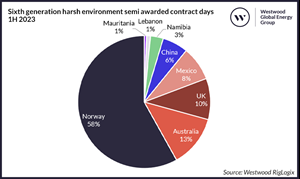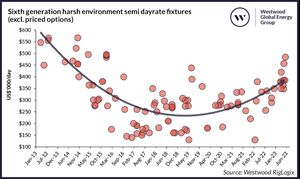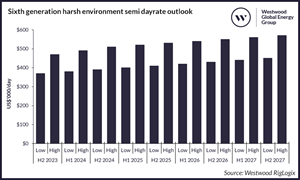Harsh environment semisub market sells out; dayrates approach $500K
In just six months, committed utilization of marketed sixth-generation harsh-environment semisubmersibles (semis) has jumped 14% and is now sold out at 100% utilization. This is a figure not recorded for this fleet since February 2014. Committed utilization includes rigs currently on hire or that have an upcoming contract. Appropriately, dayrates for recent contract fixtures have also risen, with some well above $400,000; a phenomenon not witnessed since 2015.
Contract days status. This fleet is currently made up of 27 active rigs, all of which are either on hire or have a contract starting in the future, Fig. 1. Although Northwest Europe still contributes the lion’s share of demand, with 68% of contracted days awarded this year, several of these rigs are being confirmed continuously for new work or extensions in other regions.

One of these “hot” regions is now Australia, where Transocean will relocate two of its CAT D assets for three new long-term assignments. Mexico, China and Namibia have also contributed considerable demand, thus far, in 2023. All are expected to remain critical for this fleet going forward.
Dayrates for these rigs remained strong in comparison to most other rig types during the last oil price crash and the pandemic, especially in Norway. However, apart from a few outlier deals, they have struggled to surpass the mid-$300,000s since late 2015, but this is now starting to change.
Sixth-generation harsh-environment semi average dayrates (excluding priced contract options) for contracts fixed, year-to-date, are now $394,000, which is a 32% increase compared to the full year average for 2022, Fig. 2. This is the highest average reached since 2014. Transocean and Odfjell Drilling have been especially successful at driving dayrates higher for these assets this year, securing new deals, with rates reported as high as $484,000 (Australia), $457,000 (Australia) and $420,000 (Norway), respectively (note that these rates may include other services). These three fixtures do not begin until first-quarter 2025, first-quarter 2024 and second-quarter 2024, respectively.

For those operators looking to secure a unit, the earliest availability appears to be late first-quarter 2024, when the Transocean Barents comes off hire. However, it is already being bid on follow-on opportunities, as is the case for those units rolling off contract in the second quarter.
The demand outlook for these high-specification rigs looks very bright, and recently there has been a wave of multi-year requirements brought to market from the likes of Equinor and Var Energi in Norway, which we believe represents their recognition of shrinking availability, fear of missing out on the right specification assets for drilling campaigns and, most worryingly, rising dayrates that can affect overall project economics.
And this is a valid concern. Westwood’s Global Offshore Drilling Rig Dayrate Forecast 2023-2027 (Fig. 3) suggests dayrates in this segment are set to continue their escalation over the coming years as demand for harsh-environment rigs rises, coupled with a lack of newbuild assets or reactivation candidates, which have been a saving grace for the booming drillship and jackup markets.
There are currently only three cold-stacked sixth-generation assets that could be added to the fleet, if reactivated, and just four newbuilds in shipyards. One of the latter is the North Dragon, which has been secured for a long-term campaign in Mexico. The remaining three units, the sixth-generation Beacon Pacific and the seventh-generation ex-Awilco newbuilds—Nordic Spring and Nordic Winter—are all being bid on current tenders in the market.
Westwood anticipates dayrates in this sector to continue increasing worldwide over the five-year forecast period, and we will likely see rates secured at or above $500,000 for contracts beginning in late 2024 and early 2025. The steep economics behind a reactivation campaign or commissioning a newbuild will also add further pressure to commercial terms on a new rig deal. Of course, dayrates for these units will continue to vary, depending on specific rig capabilities, when the job starts, where work will take place and the duration of the contract, but we expect to see significant increases across the fleet.
Westwood’s Global Offshore Drilling Rig Dayrate Forecast 2023-2027 report projects dayrate trends for eight of the main rig categories for jackups, semis and drillships and is published bi-annually. Data is sourced from RigLogix. For more information on how to access the report, please contact sales@westwoodenergy.com.
- Dallas Fed: Outlook improves, even as activity little changed; break-even prices increase (April 2024)
- Advancing offshore decarbonization through electrification of FPSOs (March 2024)
- The last barrel (February 2024)
- Oil and gas in the Capitals (February 2024)
- What's new in production (February 2024)
- First oil (February 2024)
- Applying ultra-deep LWD resistivity technology successfully in a SAGD operation (May 2019)
- Adoption of wireless intelligent completions advances (May 2019)
- Majors double down as takeaway crunch eases (April 2019)
- What’s new in well logging and formation evaluation (April 2019)
- Qualification of a 20,000-psi subsea BOP: A collaborative approach (February 2019)
- ConocoPhillips’ Greg Leveille sees rapid trajectory of technical advancement continuing (February 2019)



